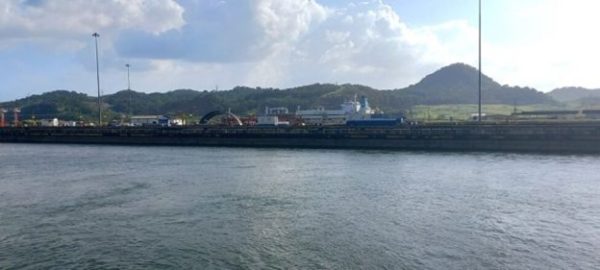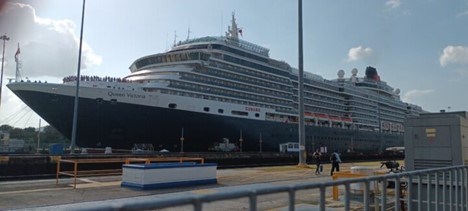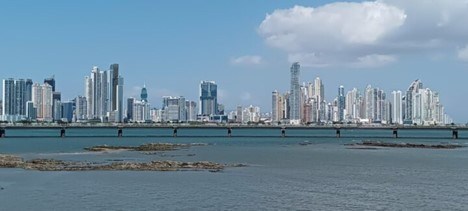Drought Narrows the Panama Canal, Delays Shipping

HAVANA TIMES – At the bar that Sandra manages in Panama City’s central financial district, the variety offered on the menu has shrunk due to delays in ship traffic through the Panama Canal, one of the world’s major shipping routes.
“We are out of stock of some of our foreign beers, because the shipment didn’t arrive. I hope it will get here one of these days,” the Panamanian bar-keeper told IPS, as she pointed to a half-empty refrigerator in the bar nestled between skyscrapers.
The delays have been repeated since drought took hold in this Central American nation throughout 2023, exacerbated by the effects of the climate crisis and the cyclical El Niño Southern Oscillation (ENSO) weather phenomenon that warms the waters of the Pacific Ocean.
This mixture of phenomena has repercussions on the forested areas surrounding the canal and the Alhajuela, Gatun and Miraflores artificial reservoirs that supply it and provide water for more than half of the country’s total population of 4.7 million people.
Due to the lack of rain, the level of Gatun Lake, the main source of water for the canal inaugurated in 1914, dropped from its normal height of 26 meters above sea level to less than 24 in recent weeks.
Six percent of the world’s maritime trade, especially container trade, goes through the canal connecting the Atlantic and Pacific oceans.
In addition, the interoceanic waterway has lost volume through evaporation due to warming water temperatures, according to a 2022 study by the Netherlands Water Partnership (NWP), a network of 180 public and private organizations.
Oscar Vallarino, a former official of the state-owned autonomous Panama Canal Authority (ACP), founded in 1978 to manage the company, said the situation stems from including the canal in its current watershed and expanding it since 2016, which doubled its capacity and the volume of ships, in addition to leading to the prohibition of the construction of more dams.
“Above and beyond the ship traffic, the canal must provide raw water for the populations of (the provinces) of Panama and Colon. The difference is that now there is more traffic and the problem is that in the dry season the salt level rises and damages the raw water for potabilization,” he told IPS.

From the Bridge of the Americas, which connects Panama City with the western part of its metropolitan area, the ships lined up to enter the canal look like figures in a board game moving slowly over a blue board. The waiting time varies, mostly en route to a U.S. port.
But the slowdown stems from the crucial element of the infrastructure: water, whose scarcity means fewer commercial vessels can cross from one ocean to the other. The reservoirs that feed the canal have a capacity of 1,857 hectoliters and currently hold only 900.
At the same time, the demand for different activities is increasing, leading to greater competition for consumption and conflicts that will intensify throughout this century.
Law 93 of 1999, modified by Law 44 of 2006, establishes the limits of the canal’s watershed, which covers 343,521 hectares and is one of 52 in the country.
The rainy season in this tropical country runs from May to November, but the last quarter of last year recorded lower rainfall, and the drought will worsen in the first half of 2024.
The population of the provinces of Panama and Colon also depends on water from the canal. But the problem is aggravated by waste, the leakage of at least 40 percent of the water due to broken pipes and the lack of efficient infrastructure.
This is despite the fact that this nation ranks fifth in the world in annual rainfall, has six times the world average of fresh water per person, in addition to 500 rivers, in an area of only 75,517 square kilometers.
But on the other hand, it has the highest individual consumption in Latin America, with 507 liters per inhabitant. Panama has an availability of about 115,000 cubic meters per inhabitant/year, according to the Inter-American Development Bank (IDB).
The consequences of the climate crisis and ENSO cloud the outlook for the water supply, since they mean that both excess and scarcity of water will create trouble for this Central American country. El Niño has reappeared in its strong phase, as meteorologists define the worst of its three modalities.
The ACP estimates that the basin captures almost 4.4 billion cubic meters (m3) annually, of which the canal consumes 70 percent for navigation and 15 percent for drinking water.

Victim of nature
In response to the crisis, the ACP adjusted the maximum draft, the daily traffic capacity and the reuse of diverted water.
As a result, it reduced the number of vessels crossing the 82-kilometer route to 24 per day from an average of between 38 and 40, which could drop to 18 this February, when traffic is expected to decline by one-third from its usual level.
In addition, it charges 10,000 dollars for water rights and auctions quotas for diverting water. Each passage requires 250 million liters of water per vessel, which is then returned to the system.
The canal already suffered an acute water crisis in 2016, but it has been aggravated now by a strong ENSO.
William Hugues, a member of the non-governmental National Front for the Defense of Social and Economic Rights, said the crisis was foreseeable and exposed the underlying aim of prioritizing the canal over the water supply to the local population.
“We issued a warning in 2006, when the expansion was being discussed, that larger locks would cause more salt water to enter Gatun. This demand would threaten the supply of drinking water. We have to accept that the canal has physical limits and we cannot respond to the dynamics of the international economy,” the economist, whose group includes social organizations, trade unions and other groups, told IPS.
Hugues, author of a book on the expansion of the canal traffic, pointed out that there is always a line of ships waiting to cross during the dry season and that the measures applied are the same as before the expansion.
Due to cargo demand, the expansion, undertaken in 2007 and completed in 2016, added two locks to accommodate the larger, heavier Neopanamax cargo ships, which need more water to transport up to 120,000 tons, especially gas cargo. But the expansion has had repercussions on the demand for water.
The use of the canal brings more than four billion dollars into the Panamanian coffers annually, approximately six percent of GDP. The drop in traffic could mean a financial loss of more than 200 million dollars a year and, therefore, will have an impact on the already stressed finances of this Central American nation.
Although it had promised to do so, the ACP did not respond to an IPS query about forecasts for canal activity in 2024.
The crisis has forced ships to take longer and more expensive routes, such as around Cape Horn, to the south of Chile, or to move cargo overland from coast to coast in Panama, before reloading it onto ships.
Palliative measures
To face the recurring crises, the ACP is studying the construction of a dam and reservoir on the Indio River, west of Gatun, and the use of the Bayano dam, which would entail different costs.
The dam costs 800 million dollars and involves the flooding and displacement of some 1,900 people in an area of 400,000 hectares, while the use of the Ascanio Villalaz hydroelectric dam, owned by the Panamanian state and the private U.S. company AES Global Power, costs three times as much.
But the effects of the climate crisis may worsen, as several recent analyses suggest.
Between 1971 and 2020, Panama experienced significant drops in precipitation, although rainfall trends varied between regions.
Thus, the eastern and central Pacific provinces were significantly drier, especially during the summertime, while the western and central Caribbean provinces were wetter, particularly during the fall, according to the Panama climate risk study published by the World Bank earlier this year.
By 2050, precipitation patterns are expected to increase, when the Pacific territories should experience a jump in rainfall, mostly in summer and autumn, and the Caribbean/Atlantic should see no net change.
The study warns that the frequency of intense floods and droughts related to ENSO will become more common and are especially critical to monitor in the canal basin and the Dry Arc, an area in the west of the country characterized by scarce rainfall.
Meanwhile, the study by the Dutch organizations warns that the measures adopted are short-term and will only limit the canal’s customers in the long term, which will affect the national economy and global pollution.
In addition, several swaths of the country, including the capital and Gatun, are expected to be flooded by 2050.
Panama has an Action Plan 2022-2026 for the integrated management of water resources, composed of 35 actions, but its implementation is proceeding slowly.
The plan seeks to contribute to water security through the prioritization of concrete actions based on national priorities, climate change scenarios, the needs of the different sectors and the institutional and financial capacity for their implementation.
The ACP itself recognizes the need for long-term investments to meet the challenges.
The country has 56 water treatment plants, seven of which are located in the canal. The expansion of several facilities and the construction of two would add some 851 million liters to the flow.
According to Vallarino, a new reservoir and the use of the Bayano dam would eventually be needed.
“We have to ask ourselves if it is feasible. Studies projecting the future should be done, to assess the options. The population is a priority. If it is well managed, we may have some setbacks, but there will be enough water for the public,” he said.
Meanwhile, Hugues said that the canal’s mercantile development rate is unsustainable.
“With the expansion of the canal, shipowners will continue to expand ships, they’ll keep growing and growing. That means we would have to make the basin the whole canal. If they follow the thesis that the canal must continue to be expanded, there will never be enough water to meet demand,” he argued.
Under the circumstances, the canal must adapt, because if it does not, drinkable water will choke in the pipes and businesses such as Sandra’s will continue to have half-empty refrigerators.





